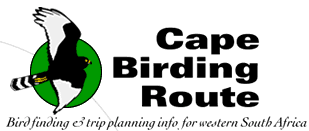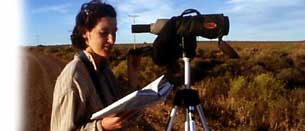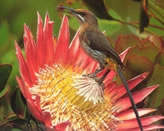Brandvlei:
An Introduction to Bushmanland
From
Calvinia, take the R27 north to Brandvlei. As you enter Bushmanland,
the landscape becomes more open and the bushes lower and sparser.
From this point on, keep alert for Black-eared
Finchlark, a nomadic species found throughout Bushmanland
and which often moves around in flocks (p.96*). While driving,
you are likely to spot the conspicuous, all-dark males fluttering
over the road, although they invariably land frustratingly
behind the bushes by the time you have stopped the car!
About
54 km north of Calvinia (95 km south of Brandvlei; use the
distance signs to orient yourself), check the pan on the left
that often contains water and Greater Flamingo,
Black-necked Grebe, Avocet and South African
Shelduck. The latter two may be seen on any pool of water
in the region. Blue
Cranes (p.72*) are regularly seen on the isolated
patch of cultivated land 55 km south of Brandvlei, where Thick-billed
and Red-capped Larks are common. There are colonies
of South African Cliff Swallow (active September to
April) under road culverts exactly 67 km, 97 km and 107 km
south of Brandvlei.
Tractrac
and Karoo Chats (see p.78) are the most common chats
in the region, although Familiar, Sickle-winged
and Ant-eating Chats may also be seen. The stocky Chat
Flycatcher often perches on telephone wires, while Karoo
Long-billed Lark (p.13), the region’s most widespread
lark, is often seen perched on the fence-posts. Rufous-eared
Warbler, Black-chested Prinia and Bokmakierie
are common on the scrubby plains, whereas Cape
Penduline Tit (p.81) prefer drainage lines. Look out
for Ludwig’s
Bustard (p.105*) and the occasional Kori
Bustard (p.116*), which are often seen in flight,
especially in the morning and early evening. The commonest
raptors are Pale Chanting Goshawk, Greater Kestrel
and Lanner Falcon, while Martial Eagle and Black-breasted
Snake-eagle are also often seen.
Although
Red Lark (p.96*)
can be quite localized, it is found widely in the Brandvlei
region and may be common where the vegetation is suitable.
One such locality is precisely 23.6 km south of Brandvlei
(1.1 km south of a picnic site), where a lone windmill stands
among a large tract of scrubby vegetation on the east side
of the road. For the best chance of success, get here early
and listen out for their calls. It is the ‘plains form’
of the Red Lark
that occurs here, which is much browner than the richly-coloured
‘dune form’ occurring near Pofadder (p.95). Karoo
Lark does not occur here. Also look out for the localized
Karoo
Eremomela (p.85*) here and in the scrub exactly 10
km south of Brandvlei. This is a relatively scarce species
in Bushmanland, unlike the Yellow-bellied Eremomela,
which is common over much of the region.
Brandvlei
is a small town of exceptionally forlorn demeanour, situated
on the plains of central Bushmanland. Its unprepossessing
appearance is deceptive, however, as excellent birding may
be had close to the town. Make an early start, leaving any
non-birding companions to sleep late in the Brandvlei Hotel.
Red Lark (p.96*)
may be searched for at the site mentioned above, but it also
occurs even closer to town: follow the R27 for 2 km north
of town, and turn left along the unsurfaced road to Granaatboskolk.
Continue for about 2 km along here, and check the scrub on
either side of the road at 1 (see map, right).
The
area to the east of Brandvlei offers some excellent Bushmanland
birding, including good sites for the desirable Sclater’s
Lark (see box) and Burchell’s
Courser (p.96*). From Brandvlei, take the gravel R357
towards Van Wyksvlei. Check the slightly thicker scrub (especially
at 2 and 5 on site map, below) for Karoo
Eremomela (p.85*). Continue to the bridge at 3, where
European Bee-eater breeds in summer, and where Pririt
Batis (p.85*) occurs in the sparse riparian vegetation.
Look for Dusky Sunbird around the occasional flowering
bush (often on rocky koppies) and in riverine trees.
Shortly
after the bridge, you will be faced with a staggered, three-point
intersection at 4. Take the northerly road, signposted ‘Van
Wyksvlei’. The entire route from Brandvlei to Van Wyksvlei
is excellent country for Sclater’s
Lark. In particular, check the habitat precisely at
7, and at 3 km beyond 7 along the R357. Much of the road towards
Van Wyksvlei is also recommended for both this species and
Burchell’s
Courser, and both can be found by driving along and
stopping at their characteristically open habitat. Check the
small farm dams for Sclater’s
Lark. Burchell’s
Courser occurs sparsely here, and over the whole of
Bushmanland. Watch for them running away from you in the distance
when walking through suitable habitat, which is usually the
most open, sparsely vegetated areas available — from
open stony plains to the grassy edges of dry pan areas. Their
unusual flight call often attracts attention. Look out for
them while driving, too, as their white wing patches are quite
conspicuous in flight. Another rewarding route for both these
species is the Haasfontein road: start from 4, and look especially
on the plains around the farm Toekoms, 27 km from 4. Red
Lark may be found 1 km east of 4.
You
may also see Karoo Korhaan and Double-banded Courser
at the roadsides, and Black-eared
Finchlark is usually present in the area. A very common
bird of the stony plains is the enchanting Spike-heeled
Lark. These birds move about in small, active groups,
jerkily scuttling about the pebbles and digging with their
bills into the soft sand accumulated around the bases of bushes.
Lark-like Bunting is often abundant. Red
Lark occurs
sparsely in the taller vegetation over this whole area: check
at 6, and also at 17.7 km beyond 7 on the R357. Namaqua
Sandgrouse are often seen flying to water in the mornings,
delivering their characteristic, bubbling ‘kelkiewyn’
calls.
|


